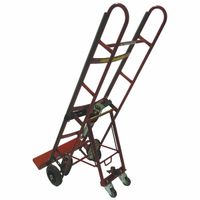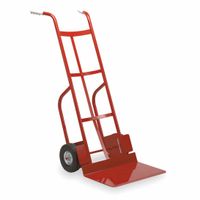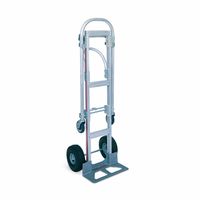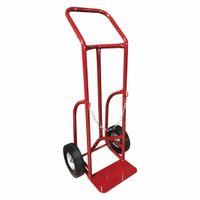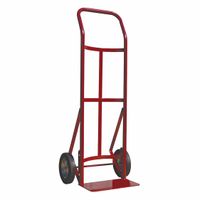Call +(254) 703 030 000 / 751 483 999 / 721 704 777
- Home
- Material Handling
- Transporting
- Hand Trucks
.....Read More
Frequently Asked Questions
What is a hand truck used for?
A hand truck, also known as a dolly, is a manual tool used to transport heavy or bulky items with ease. It consists of a flat platform or toe plate at the bottom, two wheels, and a vertical frame with handles at the top. The primary function of a hand truck is to leverage the weight of the load, allowing a person to move items that would otherwise be difficult or impossible to carry by hand.
Hand trucks are commonly used in various settings, including warehouses, retail stores, and during moving processes. They are ideal for transporting boxes, appliances, furniture, and other heavy goods. The design allows the user to slide the toe plate under the item, tilt the hand truck back, and roll the load to the desired location. This reduces the physical strain on the user and minimizes the risk of injury.
In addition to their basic design, hand trucks come in various types to suit specific needs. Convertible hand trucks can be transformed into a platform cart, offering versatility for different types of loads. Stair-climbing hand trucks are equipped with additional wheels or tracks to facilitate moving items up and down stairs. Folding hand trucks are compact and easy to store, making them convenient for personal use or in environments with limited space.
Overall, hand trucks are essential tools for efficiently and safely moving heavy items, reducing the effort required and increasing productivity in both professional and personal settings.
How do you use a hand truck safely?
To use a hand truck safely, start by inspecting it for any damage or defects, ensuring that the wheels, handles, and platform are in good condition. Choose a hand truck appropriate for the load size and weight, and never exceed its weight capacity. When loading, place heavier items at the bottom to maintain a low center of gravity, and secure the load with straps if necessary to prevent shifting.
Position the hand truck close to the load, and slide the platform underneath by tilting the load slightly if needed. Keep your back straight and bend your knees while lifting to avoid strain. Once the load is on the hand truck, tilt it back slightly to balance the weight over the wheels, ensuring that you maintain control.
When moving, push the hand truck rather than pulling it to maintain better control and visibility. Keep your path clear of obstacles and ensure that the floor is dry and free of debris. Move at a steady pace, avoiding sudden stops or turns that could destabilize the load.
When navigating inclines, move forward going up and backward going down, keeping the load uphill to prevent it from tipping over. Use ramps where available, and avoid stairs unless absolutely necessary. If stairs must be used, ensure you have assistance and take one step at a time.
Finally, when unloading, carefully lower the hand truck to the ground, keeping your back straight and bending your knees. Slide the load off the platform, ensuring it is stable before releasing it. Store the hand truck in a safe, designated area when not in use.
What is the difference between a hand truck and a dolly?
A hand truck, often referred to as a two-wheeler, is a vertical, L-shaped tool with two wheels at the base and a small platform or toe plate. It is designed to slide under an object, allowing the user to tilt the truck back and balance the load over the wheels for easy transport. Hand trucks are ideal for moving smaller, heavier items like boxes, appliances, or stacks of goods. They often have a handle at the top for steering and are used by tilting the load backward, leveraging the wheels to move the weight.
A dolly, on the other hand, is a flat platform with four wheels, sometimes with a handle for steering. It is designed to carry larger, bulkier items that may not fit on a hand truck, such as furniture or large equipment. Dollies distribute the weight of the load across four wheels, making them suitable for heavier and more cumbersome items. They come in various forms, including furniture dollies, which are flat and low to the ground, and appliance dollies, which may have straps or additional support for securing items.
The primary difference lies in their design and intended use: hand trucks are more suited for smaller, heavier loads that can be stacked, while dollies are better for larger, bulkier items. Hand trucks require the user to balance the load, whereas dollies provide a stable platform for transport. Both tools are essential for moving heavy items but are chosen based on the specific requirements of the task at hand.
How much weight can a hand truck carry?
A hand truck, also known as a dolly, is a versatile tool used for transporting heavy items. The weight capacity of a hand truck can vary significantly based on its design, materials, and intended use. Generally, standard hand trucks can carry between 200 to 800 pounds. However, heavy-duty models can handle up to 1,000 pounds or more.
The construction material plays a crucial role in determining the weight capacity. Hand trucks made from steel are typically more robust and can carry heavier loads compared to those made from aluminum, which are lighter and more suitable for moderate weights. The design of the hand truck, including the size and type of wheels, also affects its capacity. Larger pneumatic wheels can support heavier loads and provide better maneuverability over uneven surfaces, while smaller solid wheels are suitable for lighter loads on smooth surfaces.
Specialized hand trucks, such as stair-climbing models, are designed to carry heavy loads up and down stairs, often with a slightly reduced weight capacity due to the additional strain of stair navigation. Convertible hand trucks, which can switch between upright and flatbed configurations, offer flexibility in load handling but may have varying weight limits depending on the configuration.
When selecting a hand truck, it's essential to consider the specific needs of the task, including the weight of the items to be moved, the terrain, and any additional features required, such as stair-climbing capabilities or convertible designs. Always adhere to the manufacturer's guidelines and weight limits to ensure safety and prevent damage to the hand truck or injury to the user.
What are the different types of hand trucks?
1. **Standard Hand Truck**: Also known as a two-wheel dolly, it features a vertical frame with a handle at the top and a small platform at the bottom. It is ideal for moving boxes and small appliances.
2. **Convertible Hand Truck**: This versatile model can switch between a standard upright position and a flatbed cart, allowing for the transport of larger or bulkier items.
3. **Appliance Hand Truck**: Designed specifically for moving heavy appliances, it often includes straps or belts for securing items and stair climbers for easier navigation of steps.
4. **Stair Climbing Hand Truck**: Equipped with a tri-wheel or rotating wheel system, this type is designed to easily ascend and descend stairs, making it ideal for multi-level transport.
5. **Folding Hand Truck**: Lightweight and compact, this type can be folded for easy storage and is suitable for light-duty tasks and personal use.
6. **Heavy-Duty Hand Truck**: Built with reinforced frames and larger wheels, these are designed for industrial use, capable of handling heavier loads.
7. **Platform Hand Truck**: Featuring a flat platform with four wheels, it is used for transporting large, bulky items that may not fit on a standard hand truck.
8. **Specialty Hand Truck**: These are designed for specific tasks, such as cylinder hand trucks for gas tanks or drum hand trucks for barrels.
9. **Electric Hand Truck**: Powered by a battery, this type reduces manual effort and is ideal for frequent or heavy-duty use, often featuring motorized wheels for easier movement.
10. **Pallet Hand Truck**: Also known as a pallet jack, it is used for lifting and moving pallets, featuring forks that slide under the pallet for transport.
How do you choose the right hand truck for your needs?
To choose the right hand truck, consider the following factors:
1. **Load Capacity**: Determine the maximum weight you need to transport. Hand trucks typically range from 150 to 1,000 pounds. Choose one that exceeds your heaviest load to ensure safety and durability.
2. **Material**: Hand trucks are made from steel, aluminum, or plastic. Steel is strong and durable but heavy. Aluminum is lighter and resistant to rust, making it ideal for frequent use. Plastic is lightweight and suitable for lighter loads.
3. **Wheel Type**: Consider the terrain. Pneumatic wheels are air-filled and provide a smooth ride on uneven surfaces. Solid rubber wheels are maintenance-free and suitable for flat surfaces. Semi-pneumatic wheels offer a balance between the two.
4. **Handle Design**: Choose between vertical loop, horizontal loop, or dual-handle designs based on comfort and control. Ergonomic handles reduce strain during use.
5. **Convertible Options**: Some hand trucks convert into platform trucks or have additional features like stair climbers. If you need versatility, consider a convertible model.
6. **Size and Storage**: Ensure the hand truck fits through doorways and in storage spaces. Folding models are available for compact storage.
7. **Special Features**: Look for features like stair climbers, foldable toe plates, or extendable frames if you have specific needs.
8. **Budget**: Balance cost with features. Higher-priced models often offer better durability and additional features.
9. **Brand and Reviews**: Research brands known for quality and read customer reviews to gauge performance and reliability.
By evaluating these factors, you can select a hand truck that meets your specific requirements, ensuring efficiency and safety in your material handling tasks.
Can hand trucks be used on stairs?
Yes, hand trucks can be used on stairs, but it requires specific types designed for that purpose. Standard hand trucks are not suitable for stair use due to their two-wheel design, which is optimized for flat surfaces. However, stair-climbing hand trucks are equipped with special features that allow them to navigate stairs safely and efficiently.
Stair-climbing hand trucks typically have a tri-wheel or star-wheel configuration on each side. This design allows the wheels to rotate and "walk" up or down the stairs, distributing the load more evenly and reducing the effort needed to move heavy items. The tri-wheel system ensures that at least one wheel is always in contact with the stair surface, providing stability and balance.
When using a stair-climbing hand truck, it's important to follow safety guidelines to prevent accidents. Ensure the load is securely fastened to the hand truck to prevent shifting. Maintain a firm grip on the handles and keep your back straight to avoid strain. It's advisable to have a second person assist, especially when moving particularly heavy or bulky items.
In addition to manual stair-climbing hand trucks, there are powered versions available. These electric or battery-operated models further reduce the physical effort required by using a motor to assist in climbing stairs. They are particularly useful in commercial settings where frequent stair navigation is necessary.
In summary, while standard hand trucks are not suitable for stairs, specialized stair-climbing hand trucks are designed to handle such tasks safely and efficiently. Always prioritize safety and consider the weight and size of the load when choosing the appropriate hand truck for stair use.
